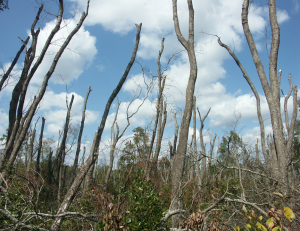
Water locust, native to the Southeast and found in wet soils, is among the U.S. tree species most vulnerable to climate change. Photo by Troy Evans, Great Smoky Mountains National Park, Bugwood.org.
What do water locust, Texas walnut, chalk maple, pyramid magnolia, two-wing silver bell, and butterbough all have in common? They’re among the U.S. tree species most vulnerable to climate change, according to a study by North Carolina State University (NCSU) and the U.S. Forest Service.
The Forest Service Forest Health Protection program sponsored the study, which was recently published in a special issue* of the journal New Forests.
The study builds on discussions at a 2014 workshop involving 25 U.S. Forest Service managers and scientists from across the country. They came together to reach consensus on a science-based and transparent process for identifying vulnerable tree species. Many species are facing genetic degradation due to rising temperatures, shifting moisture patterns, and related habitat changes. Project CAPTURE (Conservation Assessment and Prioritization of Forest Trees Under Risk of Extirpation) emerged from their discussion.
“If tree species have sufficient genetic diversity within and across populations, they may be more able to adapt to changing environmental conditions. Genetic degradation means the possibility of a significant reduction in the ability of a species to persist for the next century,” explains Kevin Potter.* Potter is an NCSU scientist cooperating with the Forest Service Eastern Forest Environmental Threat Assessment Center and the study’s lead author.
“Project CAPTURE provides a method, driven by data and expert opinion, to identify tree species that could be lost at the population level or altogether through widespread extinction. Our goal is to help scientists and managers target species and populations for proactive monitoring, management, and gene conservation.”
*Kevin Potter served as a co-editor for this special issue of New Forests, which features an introduction by Potter and colleagues, “Banking on the future: progress, challenges and opportunities for the genetic conservation of forest trees.”
For more information, see this blog posting from the U.S. Forest Service Southern Research Station.
May 23, 2017




